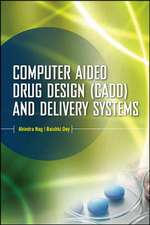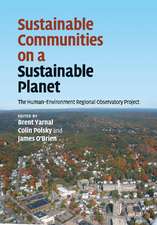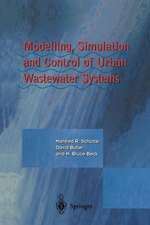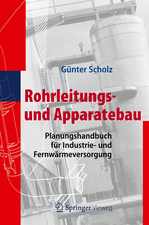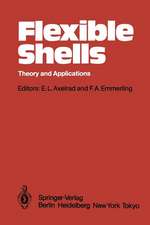CPM in Construction Management, Eighth Edition
Autor James O'Brien, Fredric Plotnicken Limba Engleză Carte – 16 dec 2015
Advance Your Construction Projects with CPM and this Fully Updated Guide
Plan, schedule, and manage construction projects using the critical path method (CPM) and the practical information contained in this thoroughly revised book. Written by two experienced engineers and authors, CPM in Construction Management, Eighth Edition, explains the evolution of CPM and fully covers the latest techniques, standards, and tools. The “John Doe” case study is used throughout to illustrate important functions, including acquiring and building the logic plan, navigation and best use of multiple software products, updating, cost control, resource planning, and delay evaluation.
This updated, hands-on guide shows how CPM:
• Works—and how to make it work for you
• Serves as the analytical tool of choice for evaluation, negotiation, resolution, and/or litigation of construction claims
• Cuts costs in a one-person operation or the most complex multinational enterprise
• Helps you stay on top of every aspect of complicated projects
• Saves big money in delay avoidance, accurate cost predictions, and claims reductions
• Multiplies the effectiveness of your instincts, experience, and knowledge
• Can be successfully implemented by properly utilizing the power of leading scheduling software products
Access to electronic content includes:
• A full-feature copy of Deltek’s Open Plan CPM software—a $2000 value
• Sample files of the “John Doe” project readable by a variety of software products
• Full color and scalable copies of all screenshots contained in the text
• Additional legacy and up-to-the-moment chapters
Preț: 730.03 lei
Preț vechi: 768.45 lei
-5% Nou
Puncte Express: 1095
Preț estimativ în valută:
139.68€ • 145.86$ • 115.35£
139.68€ • 145.86$ • 115.35£
Carte tipărită la comandă
Livrare economică 17-23 aprilie
Preluare comenzi: 021 569.72.76
Specificații
ISBN-13: 9781259587276
ISBN-10: 1259587274
Pagini: 736
Ilustrații: illustrations
Dimensiuni: 160 x 236 x 46 mm
Greutate: 1.02 kg
Ediția:Revised
Editura: McGraw Hill Education
Colecția McGraw-Hill
Locul publicării:United States
ISBN-10: 1259587274
Pagini: 736
Ilustrații: illustrations
Dimensiuni: 160 x 236 x 46 mm
Greutate: 1.02 kg
Ediția:Revised
Editura: McGraw Hill Education
Colecția McGraw-Hill
Locul publicării:United States
Cuprins
Part 1 Introduction to CPM Planning and Scheduling
Chapter 1. Introduction to Logic Based Planning and Scheduling
1.1 Scheduling Is for Everyone
1.2 We Teach Carpentry—Not “How to Use Your New Power Saw”
1.3 History of Scheduling Systems
1.4 The Ordered “To-Do” List
1.5 Gantt Charts and Bar Charts
1.6 Development of the Critical Path Method of Scheduling
1.7 Development of the PERT Method of Scheduling
1.8 Comparison of CPM and PERT
1.9 Precedence Diagramming Method
1.10 SPERT and GERT
1.11 Relationship Diagramming Method
1.12 Summary
Chapter 2. The Pure Logic Diagram
2.0 Pure Logic Network Construction
2.1 The Logic of the Logic Network
2.2 Pure Logic Diagrams
2.3 Technical Issues for Pure Logic Diagrams
2.4 Logical Loop
2.5 Form and Format for Pure Logic Networks
2.6 Events
2.7 Problems with Multi-Sheet Networks
2.8 Form and Format for Networks in PERT
2.9 Form and Format for Networks in PDM
2.10 Form and Format for Networks in RDM
2.11 Non-Construction Examples
2.12 Summary
Chapter 3. The Durations of the Logic Network
3.1 Definition of an Activity
3.2 Setting a Minimum and Maximum Duration
3.3 Estimating versus Scheduling Durations
3.4 CPM versus PERT Durations
3.5 Lags in PDM and RDM—Durations between Activities
3.6 Summary
Chapter 4. Example Project: The John Doe Project
4.1 Acquiring Information to Initial Schedule
4.2 Choosing Appropriate Codes
4.3 Activity List
4.4 Could We Prepare a Bar Chart?
4.5 Pure Network Logic
4.6 John Doe Project Pure Network Logic
4.7 Network Logic in ADM
4.8 Network Logic in PDM
4.9 Network Logic in RDM
4.10 Summary
Chapter 5. Output of Calculations
5.1 Attributes of an Event
5.2 Attributes of an Activity
5.3 The Forward Pass—TE, ES, and EF
5.4 The Backward Pass—TL, LF, and LS
5.5 The Backward Pass—TF, FF, and IF
5.6 The Backward Pass—TJ, JLF, JLS, and JTF
5.7 Calculating the Attributes of an Event or Activity
5.8 The Forward Pass—TE, ES, and EF
5.9 The Backward Pass—TL, LF, and LS
5.10 The Backward Pass—TJ, JLF, and JLS
5.11 The Backward Pass—TF, FF, JTF, and IF
5.12 Summary
Chapter 6. Cranking the Engine
6.1 Manual and Computer Solutions for PERT and ADM—The Matrix Method
6.2 Manual and Computer Solution for PERT and ADM—The Intuitive Method
6.3 Activity Start and Finish Times
6.4 Critical Activities
6.5 Total Float
6.6 Free Float
6.7 Independent Float
6.8 Time Scale Network
6.9 Computation Time
6.10 Writing Your Own CPM Software
6.11 Manual and Computer Solution for PDM with Durations between Activities
6.12 Summary
Chapter 7. Adding Complexity
7.1 Enhancements to the Basic System
7.2 Original versus Remaining Durations
7.3 Percent Complete
7.4 Defined Subtasks and Check-Off Updating
7.5 Calendar versus Work Period Conventions
7.6 Multiple Calendars
7.7 Multiple Starting and Ending Activities
7.8 Artificial Constraints to Dates
7.9 Artificial Constraints to Algorithms
7.10 Negative Float
7.11 Definition of Criticality
7.12 Continuous versus Interruptible Performance
7.13 Actual Start and Finish Dates
7.14 Retained Logic versus Progress Overrides
7.15 Events and Milestones
7.16 Hammocks and Summary Network Logic
7.17 Summary Activity Bars
7.18 User-Defined Code Fields
7.19 Adding Resources to Activities
7.20 Adding Costs and Cost Codes to Activities
7.21 Resource-Driven Scheduling
7.22 Master Schedules: Local versus System-Wide Updating
7.23 Activity Types
7.24 Hierarchical Codes
7.25 Summary
Chapter 8. PERT, SPERT, and GERT
8.1 PERT
8.2 SPERT
8.3 GERT
8.4 Computers Add Power
8.5 Summary
Chapter 9. PDM and Precedence Networks
9.1 Precedence Logic
9.2 Work Package Calculations
9.3 Computer Calculation
9.4 Project Example
9.5 Summary
Reference
Chapter 10. Respecting the Power of PDM
10.1 Durations between Activities: Percent Lead/Lag Relationships
10.2 Defining Overlapping Activities: Durations between Activities
10.3 Negative Durations between Activities
10.4 Remaining Durations between Activities
10.5 Impact of Percent Complete upon Durations between Activities
10.6 PDM and Hammocks
10.7 Continuous versus Interruptible Progress
10.8 Undefined Subtasks and Relationships to Other Activities
10.9 Multiple Calendars
10.10 Retained Logic versus Progress Override
10.11 Total Float Calculation
10.12 Erroneous Loop Errors
10.13 Summary
Chapter 11. RDM Networks Restore the Promise
11.1 Relationship Logic
11.2 Design of the Methodology for Calculation
11.3 Additional Attributes of RDM—TJ, JLF, JLS, and JTF
11.4 The Backward Pass—TJ, JLF, JLS, and JTF
11.5 Implementation by Oracle Primavera Pertmaster Risk Analysis
11.6 The Road Ahead for RDM
11.7 Summary
Chapter 12. Overview of Prevalent Software Products
12.1 Overview of Primavera Project Planner P3
12.2 Overview of SureTrak Project Planner
12.3 Overview of Primavera P6
12.4 P6 Navigation
12.5 P6 Reflection Change Maintenance Feature
12.6 P6 Multiple Float Paths
12.7 Overview of Primavera Pertmaster aka Oracle Primavera Risk Analysis
12.8 Overview of Deltek Open Plan Enterprise Project Management Software
12.9 Overview of Microsoft Project Professional 2007
12.10 Other Software Products
12.11 Summary of Overviews
Part 2 The Tools of CPM Planning and Scheduling
Chapter 13. Measure Twice—Cut Once
13.1 Preparing to Collect the Input
13.2 The Pure Logic Diagram
13.3 A Team Effort … on the Blackboard or Sketch pad
13.4 Format for Ease of Data Collection versus for Ease of Data Entry to Chosen Software
13.5 Bar Chart: May Be Based upon Logic, but Is Not a Logic Network
13.6 Logic-Restrained Bar Chart
13.7 Freehand
13.8 PERT, GERT, PDM, and RDM
13.9 Summary
Chapter 14. Choosing Codes
14.1 Calendar
14.2 Deliverable and Responsible Entity: SHT1, SHT2, RESP, and SUBC
14.3 Key Resources: CRTY, CRSZ, MHRS, SUPV, and EQUIP
14.4 Overtime, Night Work, Special Supervision, and Inspection
14.5 Quantities and Rates of Productivity
14.6 Location, Location, Location
14.7 Budget Codes for Cost: Labor, Equipment, and Materials
14.8 A Word about Codes Tied to the Activity ID
14.9 A Word about Aliases
14.10 Summary
Chapter 15. Acquiring Information for Initial Schedule
15.1 The Activity Description—A Gross Abbreviation
15.2 Activity ID, Activity Codes, and Logs
15.3 The Activity Further Defined by Resources Assigned
15.4 The Activity Further Defined by Predecessors and Successors
15.5 The Checklist of Subtasks
15.6 The Checklist of Subdeliverables (Events)
15.7 Summary
Chapter 16. Specifying Restraints
16.1 Mandatory and Discretionary Physical Restraints
16.2 Mandatory and Discretionary Resource Restraints
16.3 Mandatory and Discretionary Timing Constraints
16.4 The Misuse of Restraints and Constraints: “Nailing the Bar Down Where It Belongs”
16.5 The Need to Document the Basis of Each Restraint and Constraint
16.6 Choosing the Type of Relationship between Activities
16.7 The Case for Restricting Relationships to Traditional “FS” without Lag
16.8 The Need for Nontraditional Relationships
16.9 The Desire for Nontraditional Relationship and Resulting Misuse
16.10 Nontraditional Relationships Supported by Popular Software
16.11 Minimum Restrictions for Proper Usage of PDM
16.12 Review the Strengths of ADM: Expand the Definitions
16.13 Start of Each Activity Must Have Predecessor
16.14 Finish of Each Activity Must Have Successor
16.15 Real World Relationships between Activities
16.16 The Final Forward Pass
16.17 The Final Backward Pass
16.18 Choosing the Algorithm for the Initial Schedule
16.19 Summary
Chapter 17. Acquiring the Durations
17.1 Best Estimate with Utilization of Resources Envisioned
17.2 Compare with PERT Durations: Optimistic, Most Likely, Pessimistic
17.3 Schedule Durations versus Estimating Durations
17.4 Estimated Durations versus Calculated Durations
17.5 Do We Add Contingency Here?
17.6 Estimated Durations versus Expected Completion Dates: “As Good as the Promise”
17.7 Productivity
17.8 Durations and the Project Calendar or Calendars
17.9 Durations between Activities
17.10 Summary
Part 3 The Practice of CPM Planning and Scheduling
Chapter 18. Evolution of the Project Schedule
18.1 Preliminary Schedule
18.2 Preconstruction Analysis
18.3 Contractor Preconstruction Analysis
18.4 Milestones
18.5 The John Doe Schedule
18.6 Resources
18.7 Fast Track
18.8 Responsibility
18.9 Schedule versus Calendar
18.10 Contingency
18.11 Schedule Manipulation
18.12 Working Schedule
18.13 Summary
Chapter 19. Equipment and Workforce Planning
19.1 Workforce Leveling
19.2 Computerized Resources Planning
19.3 Resource Leveling and Smoothing
19.4 Limitations of Algorithms
19.5 Driving Resources
19.6 Resource Calendars
19.7 Practical Solutions
19.8 Summary of Resource Leveling
19.9 Turnaround Application
19.10 Examples of Resource Loading on John Doe Project
19.11 Resource Leveling Significance
19.12 Summary
Chapter 20. Procurement and Preconstruction
20.1 Scheduling Materials Procurement
20.2 RDM Just-in-Time to the Rescue
20.3 John Doe Example
20.4 Preconstruction
20.5 Predesign Phase
20.6 Design
20.7 Summary
Chapter 21. CPM and Cost Control
21.1 CPM Cost Estimate
21.2 Progress Payments
21.3 Cost Forecasting
21.4 Network Time Expediting
21.5 Minimum Cost Expediting
21.6 Earned Value Management
21.7 Summary
Chapter 22. Enterprise Scheduling
22.1 Multiproject Scheduling
22.2 Multiproject Leveling
22.3 Summarization by Enterprise Organization
22.4 The Dashboard
22.5 Program and Portfolio Management
22.6 Enterprise Software
22.7 Summary
Part 4 The Practice of CPM Scheduling
Chapter 23. Converting the Team Plan to the Calculated Schedule
23.1 Data Entry Made Easy
23.2 Check and Set Schedule Algorithm Options
23.3 First Run and Debugging the Logic
23.4 Loop Detection and Correction
23.5 Technical Review: The Primavera Diagnostic Report
23.6 Beyond the Primavera Diagnostic
23.7 First Review of Calculated Output: Reality Check 1
23.8 Detail Views of Output of Schedule Calculations
23.9 Timescaled Logic Diagram
23.10 Tailoring Initial Output to the Chosen Audiences
23.11 Whatever Owner Wants, Owner Gets
23.12 “You Can’t Always Get What You Want, But … You Get What You Need”
23.13 Reports and Views for the Foreman Performing the Work
23.14 Reports and Views for the Contractor’s Superintendent
23.15 Reports and Views for the Contractor’s Upper Management
23.16 The Narrative Report for Each Audience
23.17 Summary
Chapter 24. Engineer’s Review of the Submitted Initial CPM
24.1 Legal Aspects of a Review
24.2 Reviewing the Plan
24.3 Technical Review
24.4 Reschedule and Review the Diagnostic Report
24.5 But Is the Logic Realistic? The Smell Test
24.6 Metrics
24.7 Project Calendar or Calendars
24.8 Summary
Chapter 25. Updating the Schedule
25.1 Why Update the Schedule?
25.2 Acquiring the Data for an Update
25.3 Distinguishing Updates from Revisions
25.4 Purpose of an Update
25.5 The Purpose of a Revision
25.6 Who Should Collect Data for an Update?
25.7 Who Should Prepare Data for a Revision?
25.8 Information Required for Schedule Control: AS, RD, AF
25.9 Determination of Actual Start and Actual Finish Dates
25.10 Determination of Remaining Duration of Activities: Repeat the Steps of the Master
25.11 Expected Completion and Renewing Promises
25.12 Automatic Updates
25.13 The Forgotten Step: Determination of Remaining Duration between Activities
25.14 Save and Rename: Naming Strategies
25.15 Reports and Views to Assist Acquiring Data for an Update
25.16 Electronic Tools to Assist Acquiring Data for an Update
25.17 Choosing the Correct Algorithm for Updates
25.18 Scheduling the Update: Interpreting the Results
25.19 Technical Review: The Primavera Diagnostic Report
25.20 What to Look for When Reviewing the Update
25.21 Tailoring Update Output to the Chosen Audiences
25.22 The Narrative Report for Each Audience
25.23 Summary
Chapter 26. Revising the Logic Network
26.1 “What If” versus Committed Changes
26.2 Changes: Approved, Constructive, and at Contractor’s Cost
26.3 Revised Baseline
26.4 Update Then Revise
26.5 Summary
Chapter 27. Engineer’s Review of the Submitted Update or Revision
27.1 Is This an Update or a Revision?
27.2 The Technical Review
27.3 The Critical Path
27.4 What to Accept and What to Reject
27.5 Metrics for Updates
27.6 Revisions Are Not Updates
27.7 Minor Revision
27.8 Major Revision
27.9 Recovery Schedule
27.10 Summary
Chapter 28. Case Histories
28.1 Chicago Courthouse
28.2 Times Tower
28.3 Airport Construction
28.4 High-Rise Construction
28.5 NASA
28.6 Housing
28.7 Manufacturing Facilities
28.8 SEPTA Rail Works
28.9 New Jersey Turnpike Authority 1990–1995 Widening Program
28.10 JFK Redevelopment
28.11 Toronto Transit’s “Let’s Move” Program
28.12 Phoenixville-Mont Clare Bridge
28.13 Graduate Hospital Diagnostic Building
28.14 Interstate 76, 202, and 422 Interchange
28.15 Port Authority of New York and New Jersey
28.16 Maricopa County Jail Design and Construction Program
28.17 TXDOT SH45 Highway with Five High Bridge
28.18 Summary
Part 5 Legal Issues
Chapter 29. Specifying the CPM
29.1 Attorney’s Viewpoint on Writing a CPM Specification
29.2 Pure Logic Drawing
29.3 Content of the Logic Network
29.4 Updates and Revisions
29.5 Standard References
29.6 Sample CPM Specification
29.7 Summary
Chapter 30. Sample CPM Specification: A Guideline for Preparing Your Own Specification
30.1 Project Cpm Logic Plans, Schedules, and Reports
30.2 Project Preliminary Schedule
30.3 Project Management and Coordination
30.4 Payment Procedures
30.5 Contract Modification Procedures
Chapter 31. Unified Facilities Guide Specification
Chapter 32. CPM in Claims and Litigation
32.1 Introduction
32.2 Early Legal Recognition
32.3 Evidentiary Use of CPM
32.4 Summary
32.5 References
Chapter 33. Delay Analysis
33.1 Delay versus Disruption
33.2 Responsibility/Types/Force Majeure
33.3 As-Planned Logic Network
33.4 As-Should-Have-Been CPM Network
33.5 As-Planned Schedule
33.6 Validation of the As-Planned Logic Network and Calculated Schedule
33.7 As-Built Schedule
33.8 Validation of the As-Built Schedule
33.9 As-Built Logic Network
33.10 Causative Factors
33.11 As-Impacted Logic Network
33.12 As-Impacted Schedule
33.13 Time Impact Evaluations
33.14 Zeroing to a Collapsed As-Impacted Logic Network
33.15 Zeroing Out to an As-Should-Have-Been CPM
33.16 Limitations of the TIE Methodology
33.17 TIE Example of John Doe Project
33.18 Windows Analysis
33.19 Zeroing Out within the Windows Analysis
33.20 Windows Example of John Doe Project
33.21 Summary
Chapter 34. Disruption Analyses
34.1 Traditional Methodologies
34.2 The Measured Mile Methodology
34.3 CPM Out-of-Sequence Methodology
34.4 Adoption by the Industry
34.5 Summary
Chapter 35. Other Claim Methods
35.1 Frye versus Daubert
35.2 AACEi 29RP-03
35.3 Comparison of Three Methods for John Doe Project
35.4 Evolve or Die
35.5 The 50 Ways
35.6 Summary of Other Delay Claim Methodologies
Chapter 36. Conclusion
Appendix Navigating the Virtual CD-ROM
Index
Chapter 1. Introduction to Logic Based Planning and Scheduling
1.1 Scheduling Is for Everyone
1.2 We Teach Carpentry—Not “How to Use Your New Power Saw”
1.3 History of Scheduling Systems
1.4 The Ordered “To-Do” List
1.5 Gantt Charts and Bar Charts
1.6 Development of the Critical Path Method of Scheduling
1.7 Development of the PERT Method of Scheduling
1.8 Comparison of CPM and PERT
1.9 Precedence Diagramming Method
1.10 SPERT and GERT
1.11 Relationship Diagramming Method
1.12 Summary
Chapter 2. The Pure Logic Diagram
2.0 Pure Logic Network Construction
2.1 The Logic of the Logic Network
2.2 Pure Logic Diagrams
2.3 Technical Issues for Pure Logic Diagrams
2.4 Logical Loop
2.5 Form and Format for Pure Logic Networks
2.6 Events
2.7 Problems with Multi-Sheet Networks
2.8 Form and Format for Networks in PERT
2.9 Form and Format for Networks in PDM
2.10 Form and Format for Networks in RDM
2.11 Non-Construction Examples
2.12 Summary
Chapter 3. The Durations of the Logic Network
3.1 Definition of an Activity
3.2 Setting a Minimum and Maximum Duration
3.3 Estimating versus Scheduling Durations
3.4 CPM versus PERT Durations
3.5 Lags in PDM and RDM—Durations between Activities
3.6 Summary
Chapter 4. Example Project: The John Doe Project
4.1 Acquiring Information to Initial Schedule
4.2 Choosing Appropriate Codes
4.3 Activity List
4.4 Could We Prepare a Bar Chart?
4.5 Pure Network Logic
4.6 John Doe Project Pure Network Logic
4.7 Network Logic in ADM
4.8 Network Logic in PDM
4.9 Network Logic in RDM
4.10 Summary
Chapter 5. Output of Calculations
5.1 Attributes of an Event
5.2 Attributes of an Activity
5.3 The Forward Pass—TE, ES, and EF
5.4 The Backward Pass—TL, LF, and LS
5.5 The Backward Pass—TF, FF, and IF
5.6 The Backward Pass—TJ, JLF, JLS, and JTF
5.7 Calculating the Attributes of an Event or Activity
5.8 The Forward Pass—TE, ES, and EF
5.9 The Backward Pass—TL, LF, and LS
5.10 The Backward Pass—TJ, JLF, and JLS
5.11 The Backward Pass—TF, FF, JTF, and IF
5.12 Summary
Chapter 6. Cranking the Engine
6.1 Manual and Computer Solutions for PERT and ADM—The Matrix Method
6.2 Manual and Computer Solution for PERT and ADM—The Intuitive Method
6.3 Activity Start and Finish Times
6.4 Critical Activities
6.5 Total Float
6.6 Free Float
6.7 Independent Float
6.8 Time Scale Network
6.9 Computation Time
6.10 Writing Your Own CPM Software
6.11 Manual and Computer Solution for PDM with Durations between Activities
6.12 Summary
Chapter 7. Adding Complexity
7.1 Enhancements to the Basic System
7.2 Original versus Remaining Durations
7.3 Percent Complete
7.4 Defined Subtasks and Check-Off Updating
7.5 Calendar versus Work Period Conventions
7.6 Multiple Calendars
7.7 Multiple Starting and Ending Activities
7.8 Artificial Constraints to Dates
7.9 Artificial Constraints to Algorithms
7.10 Negative Float
7.11 Definition of Criticality
7.12 Continuous versus Interruptible Performance
7.13 Actual Start and Finish Dates
7.14 Retained Logic versus Progress Overrides
7.15 Events and Milestones
7.16 Hammocks and Summary Network Logic
7.17 Summary Activity Bars
7.18 User-Defined Code Fields
7.19 Adding Resources to Activities
7.20 Adding Costs and Cost Codes to Activities
7.21 Resource-Driven Scheduling
7.22 Master Schedules: Local versus System-Wide Updating
7.23 Activity Types
7.24 Hierarchical Codes
7.25 Summary
Chapter 8. PERT, SPERT, and GERT
8.1 PERT
8.2 SPERT
8.3 GERT
8.4 Computers Add Power
8.5 Summary
Chapter 9. PDM and Precedence Networks
9.1 Precedence Logic
9.2 Work Package Calculations
9.3 Computer Calculation
9.4 Project Example
9.5 Summary
Reference
Chapter 10. Respecting the Power of PDM
10.1 Durations between Activities: Percent Lead/Lag Relationships
10.2 Defining Overlapping Activities: Durations between Activities
10.3 Negative Durations between Activities
10.4 Remaining Durations between Activities
10.5 Impact of Percent Complete upon Durations between Activities
10.6 PDM and Hammocks
10.7 Continuous versus Interruptible Progress
10.8 Undefined Subtasks and Relationships to Other Activities
10.9 Multiple Calendars
10.10 Retained Logic versus Progress Override
10.11 Total Float Calculation
10.12 Erroneous Loop Errors
10.13 Summary
Chapter 11. RDM Networks Restore the Promise
11.1 Relationship Logic
11.2 Design of the Methodology for Calculation
11.3 Additional Attributes of RDM—TJ, JLF, JLS, and JTF
11.4 The Backward Pass—TJ, JLF, JLS, and JTF
11.5 Implementation by Oracle Primavera Pertmaster Risk Analysis
11.6 The Road Ahead for RDM
11.7 Summary
Chapter 12. Overview of Prevalent Software Products
12.1 Overview of Primavera Project Planner P3
12.2 Overview of SureTrak Project Planner
12.3 Overview of Primavera P6
12.4 P6 Navigation
12.5 P6 Reflection Change Maintenance Feature
12.6 P6 Multiple Float Paths
12.7 Overview of Primavera Pertmaster aka Oracle Primavera Risk Analysis
12.8 Overview of Deltek Open Plan Enterprise Project Management Software
12.9 Overview of Microsoft Project Professional 2007
12.10 Other Software Products
12.11 Summary of Overviews
Part 2 The Tools of CPM Planning and Scheduling
Chapter 13. Measure Twice—Cut Once
13.1 Preparing to Collect the Input
13.2 The Pure Logic Diagram
13.3 A Team Effort … on the Blackboard or Sketch pad
13.4 Format for Ease of Data Collection versus for Ease of Data Entry to Chosen Software
13.5 Bar Chart: May Be Based upon Logic, but Is Not a Logic Network
13.6 Logic-Restrained Bar Chart
13.7 Freehand
13.8 PERT, GERT, PDM, and RDM
13.9 Summary
Chapter 14. Choosing Codes
14.1 Calendar
14.2 Deliverable and Responsible Entity: SHT1, SHT2, RESP, and SUBC
14.3 Key Resources: CRTY, CRSZ, MHRS, SUPV, and EQUIP
14.4 Overtime, Night Work, Special Supervision, and Inspection
14.5 Quantities and Rates of Productivity
14.6 Location, Location, Location
14.7 Budget Codes for Cost: Labor, Equipment, and Materials
14.8 A Word about Codes Tied to the Activity ID
14.9 A Word about Aliases
14.10 Summary
Chapter 15. Acquiring Information for Initial Schedule
15.1 The Activity Description—A Gross Abbreviation
15.2 Activity ID, Activity Codes, and Logs
15.3 The Activity Further Defined by Resources Assigned
15.4 The Activity Further Defined by Predecessors and Successors
15.5 The Checklist of Subtasks
15.6 The Checklist of Subdeliverables (Events)
15.7 Summary
Chapter 16. Specifying Restraints
16.1 Mandatory and Discretionary Physical Restraints
16.2 Mandatory and Discretionary Resource Restraints
16.3 Mandatory and Discretionary Timing Constraints
16.4 The Misuse of Restraints and Constraints: “Nailing the Bar Down Where It Belongs”
16.5 The Need to Document the Basis of Each Restraint and Constraint
16.6 Choosing the Type of Relationship between Activities
16.7 The Case for Restricting Relationships to Traditional “FS” without Lag
16.8 The Need for Nontraditional Relationships
16.9 The Desire for Nontraditional Relationship and Resulting Misuse
16.10 Nontraditional Relationships Supported by Popular Software
16.11 Minimum Restrictions for Proper Usage of PDM
16.12 Review the Strengths of ADM: Expand the Definitions
16.13 Start of Each Activity Must Have Predecessor
16.14 Finish of Each Activity Must Have Successor
16.15 Real World Relationships between Activities
16.16 The Final Forward Pass
16.17 The Final Backward Pass
16.18 Choosing the Algorithm for the Initial Schedule
16.19 Summary
Chapter 17. Acquiring the Durations
17.1 Best Estimate with Utilization of Resources Envisioned
17.2 Compare with PERT Durations: Optimistic, Most Likely, Pessimistic
17.3 Schedule Durations versus Estimating Durations
17.4 Estimated Durations versus Calculated Durations
17.5 Do We Add Contingency Here?
17.6 Estimated Durations versus Expected Completion Dates: “As Good as the Promise”
17.7 Productivity
17.8 Durations and the Project Calendar or Calendars
17.9 Durations between Activities
17.10 Summary
Part 3 The Practice of CPM Planning and Scheduling
Chapter 18. Evolution of the Project Schedule
18.1 Preliminary Schedule
18.2 Preconstruction Analysis
18.3 Contractor Preconstruction Analysis
18.4 Milestones
18.5 The John Doe Schedule
18.6 Resources
18.7 Fast Track
18.8 Responsibility
18.9 Schedule versus Calendar
18.10 Contingency
18.11 Schedule Manipulation
18.12 Working Schedule
18.13 Summary
Chapter 19. Equipment and Workforce Planning
19.1 Workforce Leveling
19.2 Computerized Resources Planning
19.3 Resource Leveling and Smoothing
19.4 Limitations of Algorithms
19.5 Driving Resources
19.6 Resource Calendars
19.7 Practical Solutions
19.8 Summary of Resource Leveling
19.9 Turnaround Application
19.10 Examples of Resource Loading on John Doe Project
19.11 Resource Leveling Significance
19.12 Summary
Chapter 20. Procurement and Preconstruction
20.1 Scheduling Materials Procurement
20.2 RDM Just-in-Time to the Rescue
20.3 John Doe Example
20.4 Preconstruction
20.5 Predesign Phase
20.6 Design
20.7 Summary
Chapter 21. CPM and Cost Control
21.1 CPM Cost Estimate
21.2 Progress Payments
21.3 Cost Forecasting
21.4 Network Time Expediting
21.5 Minimum Cost Expediting
21.6 Earned Value Management
21.7 Summary
Chapter 22. Enterprise Scheduling
22.1 Multiproject Scheduling
22.2 Multiproject Leveling
22.3 Summarization by Enterprise Organization
22.4 The Dashboard
22.5 Program and Portfolio Management
22.6 Enterprise Software
22.7 Summary
Part 4 The Practice of CPM Scheduling
Chapter 23. Converting the Team Plan to the Calculated Schedule
23.1 Data Entry Made Easy
23.2 Check and Set Schedule Algorithm Options
23.3 First Run and Debugging the Logic
23.4 Loop Detection and Correction
23.5 Technical Review: The Primavera Diagnostic Report
23.6 Beyond the Primavera Diagnostic
23.7 First Review of Calculated Output: Reality Check 1
23.8 Detail Views of Output of Schedule Calculations
23.9 Timescaled Logic Diagram
23.10 Tailoring Initial Output to the Chosen Audiences
23.11 Whatever Owner Wants, Owner Gets
23.12 “You Can’t Always Get What You Want, But … You Get What You Need”
23.13 Reports and Views for the Foreman Performing the Work
23.14 Reports and Views for the Contractor’s Superintendent
23.15 Reports and Views for the Contractor’s Upper Management
23.16 The Narrative Report for Each Audience
23.17 Summary
Chapter 24. Engineer’s Review of the Submitted Initial CPM
24.1 Legal Aspects of a Review
24.2 Reviewing the Plan
24.3 Technical Review
24.4 Reschedule and Review the Diagnostic Report
24.5 But Is the Logic Realistic? The Smell Test
24.6 Metrics
24.7 Project Calendar or Calendars
24.8 Summary
Chapter 25. Updating the Schedule
25.1 Why Update the Schedule?
25.2 Acquiring the Data for an Update
25.3 Distinguishing Updates from Revisions
25.4 Purpose of an Update
25.5 The Purpose of a Revision
25.6 Who Should Collect Data for an Update?
25.7 Who Should Prepare Data for a Revision?
25.8 Information Required for Schedule Control: AS, RD, AF
25.9 Determination of Actual Start and Actual Finish Dates
25.10 Determination of Remaining Duration of Activities: Repeat the Steps of the Master
25.11 Expected Completion and Renewing Promises
25.12 Automatic Updates
25.13 The Forgotten Step: Determination of Remaining Duration between Activities
25.14 Save and Rename: Naming Strategies
25.15 Reports and Views to Assist Acquiring Data for an Update
25.16 Electronic Tools to Assist Acquiring Data for an Update
25.17 Choosing the Correct Algorithm for Updates
25.18 Scheduling the Update: Interpreting the Results
25.19 Technical Review: The Primavera Diagnostic Report
25.20 What to Look for When Reviewing the Update
25.21 Tailoring Update Output to the Chosen Audiences
25.22 The Narrative Report for Each Audience
25.23 Summary
Chapter 26. Revising the Logic Network
26.1 “What If” versus Committed Changes
26.2 Changes: Approved, Constructive, and at Contractor’s Cost
26.3 Revised Baseline
26.4 Update Then Revise
26.5 Summary
Chapter 27. Engineer’s Review of the Submitted Update or Revision
27.1 Is This an Update or a Revision?
27.2 The Technical Review
27.3 The Critical Path
27.4 What to Accept and What to Reject
27.5 Metrics for Updates
27.6 Revisions Are Not Updates
27.7 Minor Revision
27.8 Major Revision
27.9 Recovery Schedule
27.10 Summary
Chapter 28. Case Histories
28.1 Chicago Courthouse
28.2 Times Tower
28.3 Airport Construction
28.4 High-Rise Construction
28.5 NASA
28.6 Housing
28.7 Manufacturing Facilities
28.8 SEPTA Rail Works
28.9 New Jersey Turnpike Authority 1990–1995 Widening Program
28.10 JFK Redevelopment
28.11 Toronto Transit’s “Let’s Move” Program
28.12 Phoenixville-Mont Clare Bridge
28.13 Graduate Hospital Diagnostic Building
28.14 Interstate 76, 202, and 422 Interchange
28.15 Port Authority of New York and New Jersey
28.16 Maricopa County Jail Design and Construction Program
28.17 TXDOT SH45 Highway with Five High Bridge
28.18 Summary
Part 5 Legal Issues
Chapter 29. Specifying the CPM
29.1 Attorney’s Viewpoint on Writing a CPM Specification
29.2 Pure Logic Drawing
29.3 Content of the Logic Network
29.4 Updates and Revisions
29.5 Standard References
29.6 Sample CPM Specification
29.7 Summary
Chapter 30. Sample CPM Specification: A Guideline for Preparing Your Own Specification
30.1 Project Cpm Logic Plans, Schedules, and Reports
30.2 Project Preliminary Schedule
30.3 Project Management and Coordination
30.4 Payment Procedures
30.5 Contract Modification Procedures
Chapter 31. Unified Facilities Guide Specification
Chapter 32. CPM in Claims and Litigation
32.1 Introduction
32.2 Early Legal Recognition
32.3 Evidentiary Use of CPM
32.4 Summary
32.5 References
Chapter 33. Delay Analysis
33.1 Delay versus Disruption
33.2 Responsibility/Types/Force Majeure
33.3 As-Planned Logic Network
33.4 As-Should-Have-Been CPM Network
33.5 As-Planned Schedule
33.6 Validation of the As-Planned Logic Network and Calculated Schedule
33.7 As-Built Schedule
33.8 Validation of the As-Built Schedule
33.9 As-Built Logic Network
33.10 Causative Factors
33.11 As-Impacted Logic Network
33.12 As-Impacted Schedule
33.13 Time Impact Evaluations
33.14 Zeroing to a Collapsed As-Impacted Logic Network
33.15 Zeroing Out to an As-Should-Have-Been CPM
33.16 Limitations of the TIE Methodology
33.17 TIE Example of John Doe Project
33.18 Windows Analysis
33.19 Zeroing Out within the Windows Analysis
33.20 Windows Example of John Doe Project
33.21 Summary
Chapter 34. Disruption Analyses
34.1 Traditional Methodologies
34.2 The Measured Mile Methodology
34.3 CPM Out-of-Sequence Methodology
34.4 Adoption by the Industry
34.5 Summary
Chapter 35. Other Claim Methods
35.1 Frye versus Daubert
35.2 AACEi 29RP-03
35.3 Comparison of Three Methods for John Doe Project
35.4 Evolve or Die
35.5 The 50 Ways
35.6 Summary of Other Delay Claim Methodologies
Chapter 36. Conclusion
Appendix Navigating the Virtual CD-ROM
Index





